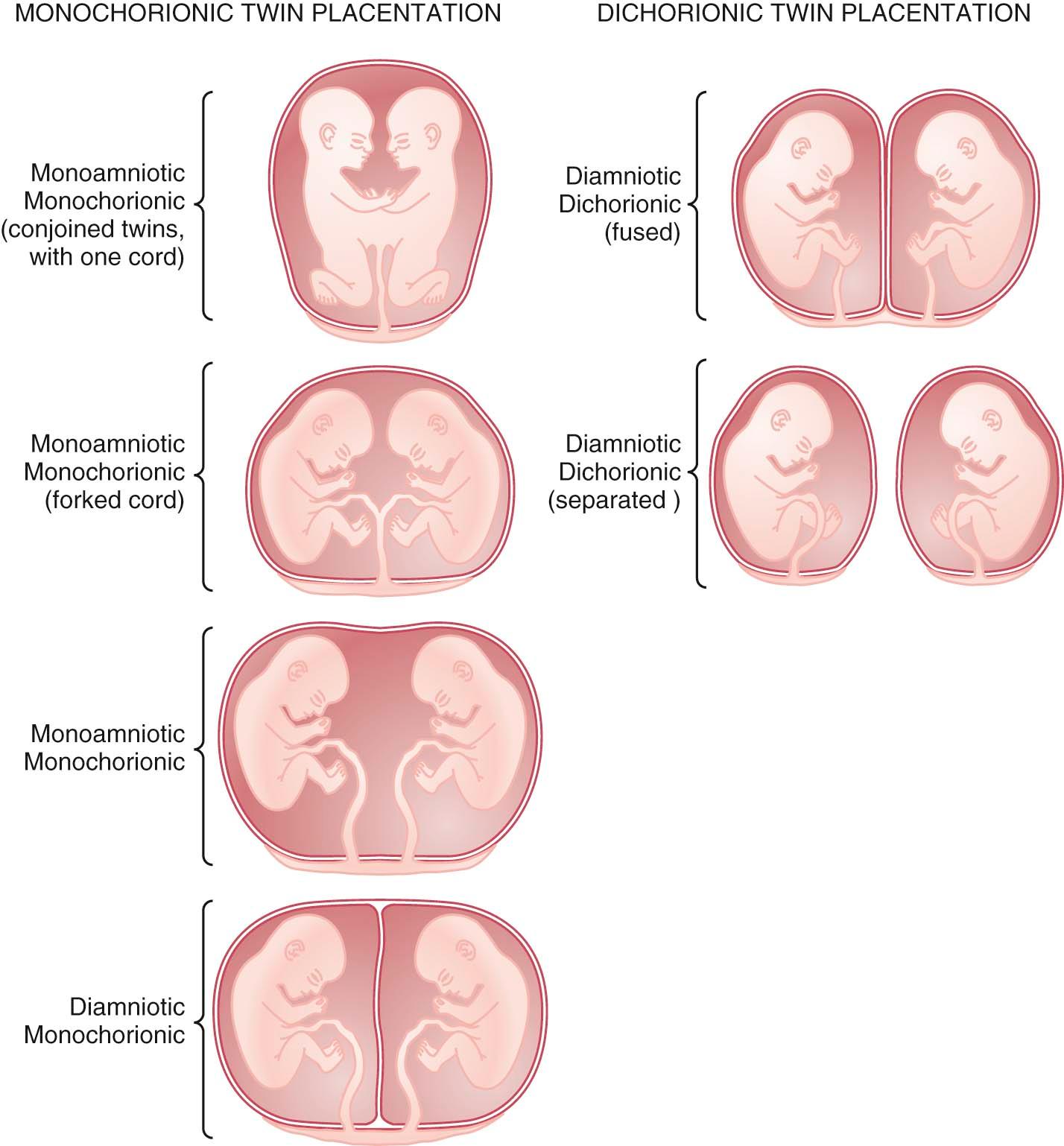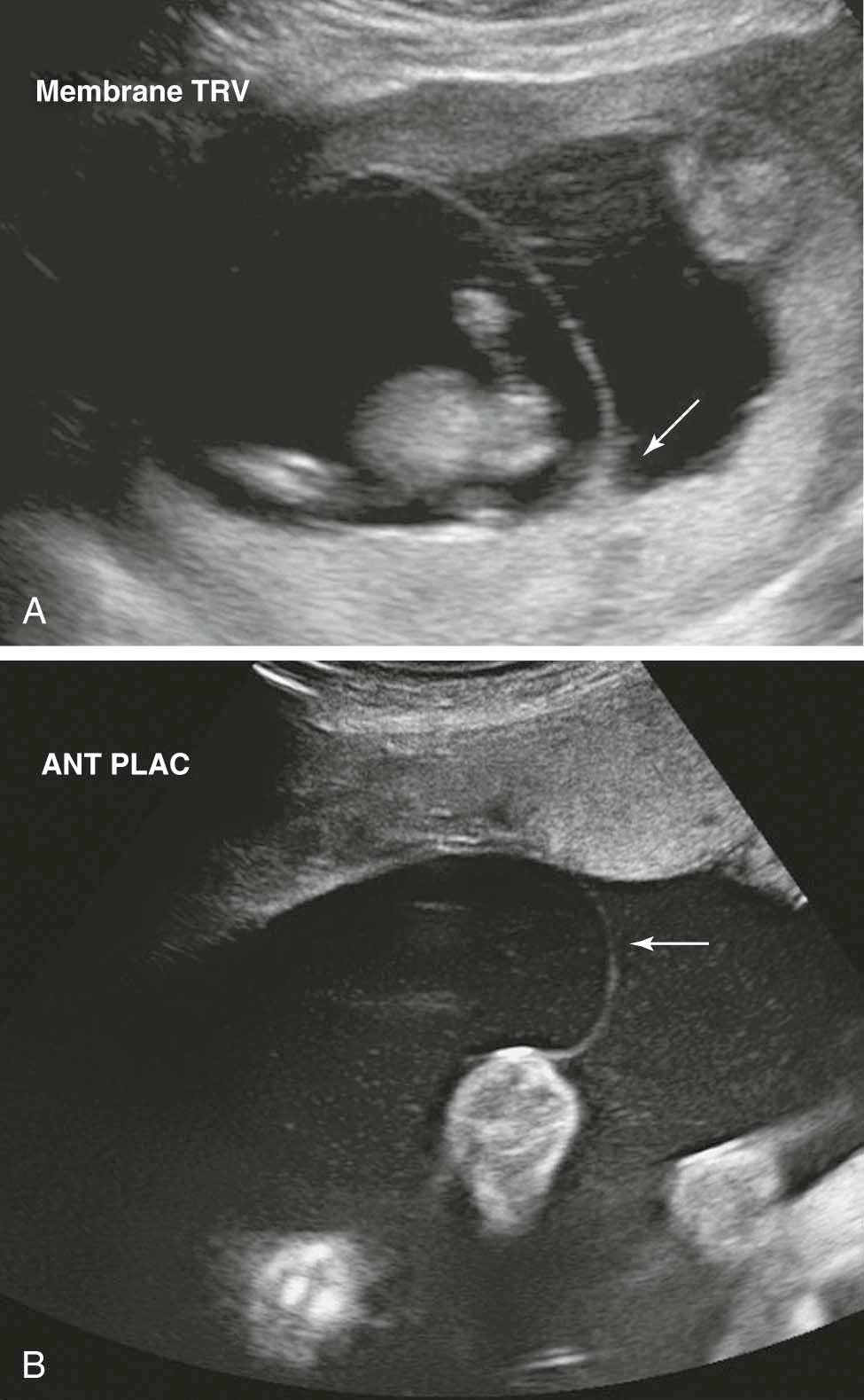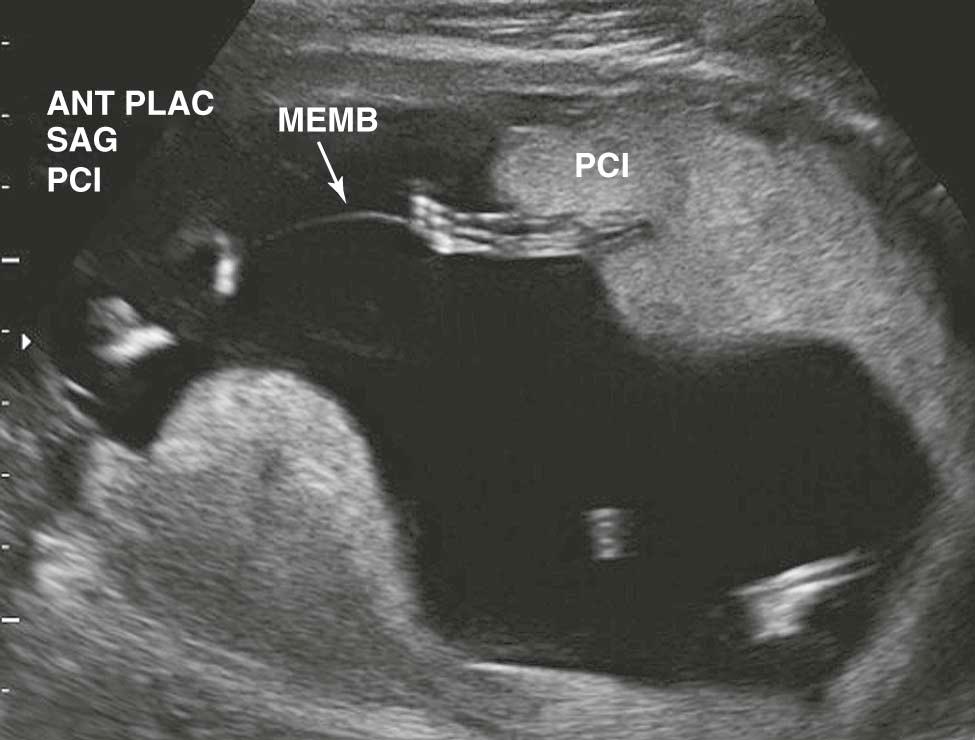Physical Address
304 North Cardinal St.
Dorchester Center, MA 02124
In the United States and other developed countries, multiple gestations have increased, and currently account for at least 3.5% of live births. The two major reasons for this increase have been the use of assisted reproductive technologies (ARTs) to treat infertility, and the increasing maternal age of women having children. Twins are twice as likely in women over the age of 35. Complications of pregnancy such as preeclampsia, preterm birth, poor fetal growth, and monochorionicity significantly increase the risk of perinatal morbidity and mortality in multifetal gestations.
The prognosis and the risk for morbidity are dependent on zygosity (the genetic makeup of the zygote). Ultrasonographic evaluation of the pregnancy is helpful in determining zygosity. Monozygotic twins (monochorionic) are more likely to involve congenital anomalies, weight discordance, twin-twin transfusion syndrome (TTTS), and other morbidity. Discordant fetal gender confirms dizygotic (two chorions) gestations and visualization of a thick amnio-chorionic septum is suggestive of dizygotic twins. Confirmation of the zygosity may require detailed examination of the placenta at delivery.
There are significant physiologic adaptations that must occur with multiple gestations. In a normal pregnancy, the maternal blood volume is augmented by 40% (2 L) over the nonpregnant baseline, while in multiple gestations the blood volume increases by 3 L or more. These changes are associated with a significantly increased risk of iron and folate deficiency, and an increase in preeclampsia, hypertension, and maternal respiratory problems such as shortness of breath (dyspnea).
Management of twin gestations during pregnancy and delivery depends upon the type of problems that develop during pregnancy such as preterm labor, poor fetal growth, hypertensive disorders, and how the fetuses present at the onset of labor. The key is to establish a plan of management that assures a safe delivery at or near term. Generally, if the first twin (twin A) is in a vertex position and the delivery is by the vaginal route, it is appropriate to plan to deliver twin B vaginally. When twin A is breech, the general consensus is that the birth of both twins should be by cesarean delivery.
Common malpresentations include breech (the most common), face, and brow. Face and brow presentations occur in about 1 in 500 and 1 in 1400 deliveries, respectively. Compound and shoulder presentations are rare, and usually are associated with premature births. Persistent brow presentations almost always require cesarean delivery.
Multiple gestations are defined as any pregnancy in which two or more embryos or fetuses occupy the uterus simultaneously. It is of utmost importance to recognize multiple gestations as a complication of pregnancy. Because twins deliver at a mean gestational age of about 36 weeks, the perinatal mortality and morbidity for multiple gestations disproportionately exceed that of singleton pregnancies. Maternal morbidity is also increased, because of the additional physiologic stresses associated with two (or more) fetuses and placentas and a rapidly enlarging uterus.
The term malpresentation encompasses any fetal position other than vertex at delivery, and includes breech, face, brow, compound, and shoulder presentations. Both fetal and maternal factors contribute to the occurrence of a malpresentation. The most common malpresentation is breech.
Multiple gestations include twins, identical and fraternal, and high-order multiple gestations that consist of three or more fetuses.
Multiple gestations occur either as the result of the splitting of an embryo (i.e., identical or monozygotic twinning ) or the fertilization of two or more eggs produced in a single menstrual cycle (i.e., fraternal or dizygotic twinning ). Because dizygotic twins arise from separate eggs, they are structurally distinct pregnancies coexisting in a single uterus, each with its own amnion, chorion, and placenta. Monozygotic twins arise from cleavage of a single fertilized egg at various stages during embryogenesis, and thus the arrangement of the fetal membranes and placentas will depend on the time at which the embryo divides ( Table 13-1 ). The earlier the embryo splits, the more separate the membranes and placentas will be. If division occurs within the first 72 hours of fertilization, the membranes will be diamniotic, dichorionic with a thick, four-layered intervening membrane. If division occurs after 4 to 8 days of development, when the chorion has already formed, monochorionic, diamniotic twins will evolve with a thin, two-layered septum. If splitting occurs after 8 days, when both amnion and chorion have already formed, the result will be monochorionic, monoamniotic, twins residing in a single sac with no septum. Of all monozygotic twins, 30% are dichorionic, diamniotic, and 69% are monochorionic, diamniotic. Only 1% of twins are monoamnionic. Because twins share a sac in this type, without an intervening membrane, the risk of umbilical cord entanglement is high, resulting in a net mortality in these twins of almost 50% ( Figure 13-1 ).
| Time of Cleavage * | Nature of Membranes |
|---|---|
| 0-72 hr | Diamniotic, dichorionic |
| 4-8 days | Diamniotic, monochorionic |
| 9-12 days | Monoamniotic, monochorionic |

Twins account for approximately 3.5% of all births in the United States. The frequency of monozygotic twinning, which depends on a very infrequent biologic event (embryo splitting), is constant in all populations studied at about 1 in 250 births. However, the frequency of dizygotic twinning, which arises from multiple ovulations in the mother, is strongly influenced by family history, ethnicity, and maternal age. A family history of dizygotic but not monozygotic twins in the maternal pedigree increases the likelihood of dizygotic twinning in subsequent generations. In western Nigeria, twinning occurs in 1 of 22 gestations, whereas in the Native American and Inuit populations, twinning is less than one-fifth of that rate. Twins are twice as common in women over 35 as in women at 25 years of age. Given these statistics, approximately two-thirds of spontaneously conceived twins are fraternal and one-third are identical (monozygotic). However, in recent years, the incidence of multizygotic multifetal gestation has increased markedly with the more widespread use of ovulation induction agents and the practice of transferring multiple embryos after in vitro fertilization. The incidence of multiple gestations following the use of clomiphene is about 6-8% and about 20-30% following gonadotropin therapy.
The prognosis and expected morbidity of twins is strongly dependent on zygosity: monozygotic twins are more likely to have congenital anomalies, weight discordance, twin-twin transfusion syndrome, neurologic morbidity, premature delivery, and fetal death. Thus, determination of zygosity is the most important next step after multifetal pregnancy has been first diagnosed.
Ultrasonographic evaluation of the pregnancy is frequently very helpful in determining zygosity. Imaging of discordant fetal gender confirms a dizygotic gestation. Visualization of a thick amnion-chorionic septum is suggestive of dizygotic twins, as is the presence of a “peak” or inverted “V” at the base of the membrane septum ( Figure 13-2, A ). Conversely, in a monochorionic gestation, the dividing membrane is fairly thin (see Figure 13-2, B ). Because an early embryonic split can infrequently result in dichorionic, diamniotic twins with separate placentas, these findings are not definitive. Similarly, in rare cases of postzygotic genetic events, monochorionic twins may be gender discordant. Thus, definitive diagnosis of zygosity may require detailed examination of the placenta after delivery. Thirty percent of twins will be of different sex and are, therefore, dizygotic. Twenty-three percent have monochorionic placentas and are, therefore, monozygotic. Twenty-seven percent will have the same sex, dichorionic placentas, but different blood groupings, and must be, therefore, dizygotic. Twenty percent will have the same sex, dichorionic placentas, and identical blood groupings. For the latter group, further studies, such as human leukocyte antigen (HLA) typing or DNA analysis, will be required to allow determination of zygosity.

Among monozygotic multiple gestations, abnormalities in the twinning process are relatively common and include conjoined twins, interplacental vascular anastomoses, twin-twin transfusion syndrome (TTTS), fetal malformations, and umbilical cord abnormalities.
If division of the embryo occurs very late (13 days, after the embryonic disc has completely formed), cleavage of the embryo will be incomplete, resulting in conjoined twins. Fortunately, this is a very rare event, occurring once in 70,000 deliveries. Conjoined twins are classified according to the anatomic location of the incomplete splitting: thoracopagus (anterior), pygopagus (posterior), craniopagus (cephalic), or ischiopagus (caudal). The majority of such twins are thoracopagus. Delivery of conjoined twins frequently requires cesarean delivery, but postnatally, these gestations have a surprisingly optimistic prognosis in many cases. More advanced contemporary imaging has allowed detailed mapping of the shared organs and more successful surgical separations.
Interplacental vascular anastomoses occur almost exclusively in monochorionic twins at a rate of 90% or more. The most common type is arterial-arterial, followed by arterial-venous and then venous-venous. Vascular communications between the two fetuses via the placenta may give rise to a number of problems, including abortion, hydramnios, TTTS, and fetal malformations. Overall, the incidence of both minor and major congenital malformations in twins is twice that of singletons, with the greater incidence of malformations occurring in monochorionic twins.
The presence of unbalanced anastomoses in the placenta (typically arterial-venous connections) leads to a syndrome in which the circulation of one twin perfuses that of the other (i.e., TTTS) in approximately 10% of monozygotic twins. In this syndrome, arterial blood from the “donor twin” enters the placenta (via the umbilical artery) and is taken up by the umbilical venous system belonging to the “recipient twin,” which results in a net transfer of blood from the “donor” to the recipient twin. Fetal complications include hypovolemia, hypotension, anemia, oligohydramnios, and growth restriction in the donor twin, and hypervolemia, hydramnios, hyperviscosity, thrombosis, hypertension, cardiomegaly, polycythemia, edema, and congestive heart failure in the recipient twin. Both twins are at risk of demise from the circulatory derangement, and the pregnancy is predisposed to preterm delivery due to overdistention of the uterus with hydramnios.
Twin to twin transfusion is diagnosed using ultrasound. Typically, the donor twin is smaller and may have oligohydramnios, absent bladder, and anemia. The recipient twin, on the other hand, is larger with possible polyhydramnios, cardiomegaly, and ascites or hydrops ( Figure 13-3 ).

Given the poor prognosis of untreated TTTS (approximately 50% survival of any twin), treatment with either serial amniocenteses with fluid reduction from the recipient twin's sac, or laser photocoagulation of the anastomotic vessels on the surface of the placenta, are performed in specialized centers.
Arterial-arterial placental anastomoses can result in fetal structural malformations. In this situation, the arterial blood from the donor twin enters the arterial circulation of the recipient twin, and the reversed blood flow may cause thrombosis within critical organs or atresias due to trophoblastic embolization. The recipient twin, being perfused in a reverse direction with relatively poorly oxygenated blood, fails to develop normally. This so-called acardiac twin typically has aplastic and/or dysmorphic anatomical development cephalad of the abdomen, but often has fully formed lower extremities.
Abnormalities of the umbilical cord occur with a higher frequency in twins and are primarily associated with monochorionic twins. Absence of one umbilical artery occurs in about 3-4% of twins, as opposed to 0.5-1% of singletons. The absence of one umbilical artery is significant because in 30% of such cases, it is associated with other congenital anomalies (e.g., renal agenesis). Marginal and velamentous umbilical cord insertions also occur more frequently in twins and may cause growth abnormalities, particularly in the third trimester.
It is not unusual for one twin to die in utero remote from term, whereas the remaining twin and the pregnancy continue to be viable. Over time (after 3 weeks or more in pregnancies that have progressed beyond 20 weeks), the retained dead fetus syndrome can develop, which involves disseminated intravascular coagulopathy in the mother as a result of the transfer of nonviable fetal material with thromboplastin-like activity into the maternal circulation. In such cases, the maternal platelet count and fibrinogen levels should be checked once a week to identify possible coagulation abnormalities. The dead fetus will be reabsorbed if the demise occurs before 12 weeks' gestation. Beyond this time, the fetus will shrink and become dehydrated and flattened (fetus papyraceus).
A number of normal maternal physiologic responses to pregnancy are exaggerated with multiple gestations. Whereas in normal pregnancy, maternal blood volume is augmented by 40% (2 L over the nonpregnant baseline), in twins this increase may be 3 L or more. The increased blood volume and demand for iron and folate increase the risk of anemia in the mother and make the patient less able to tolerate the stresses of infection, labor, and premature labor. Preeclampsia and gestational hypertension are almost doubled in multifetal gestation. The increased uterine size associated with multiple fetuses can cause maternal respiratory embarrassment, orthostatic hypotension due to compression of the vena cava, and compromised renal function due to compression of the ureters.
Historical factors such as a maternal family history of dizygotic twinning, the use of fertility drugs, a maternal sensation of feeling larger than with previous pregnancies, or a sensation of excessive fetal movements should raise the suspicion of twins. Physical signs, including excessive weight gain, excessive uterine fundal growth, and auscultation of fetal hearts in separate quadrants of the uterus are suggestive but not diagnostic. An obstetric ultrasound should be performed when a multiple gestation is suspected. The diagnosis of multiple gestations requires a sonographic examination demonstrating two separate fetuses and heart activities, and can be made as early as 6 weeks' gestation.
Become a Clinical Tree membership for Full access and enjoy Unlimited articles
If you are a member. Log in here